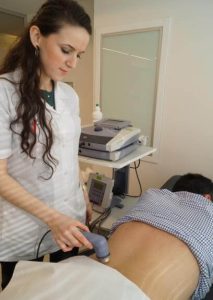What is Physical Therapy?
Physical therapy means the application of physical agents such as heat, light, electric, ultrasound, laser, electromagnetic field, pressure for musculoskeletal nervous system disorders. The number of physical therapy applications arise in line with the advancements in modern medicine.It is of the physician’s choice to use physical therapy agents as monotherapy or in preparation phase for exercise or rehabilitation.

Short Wave Diathermy
A treatment method where high frequency Electromagnetic waves are used to generate deep heat on body tissues. It is primarily used in treatments regarding joints.
Infrared Therapy
A treatment method where infrared waves are used to generate heat on superficial tissues. Provides a warm relaxing effect.
Paraffin Treatment
Paraffin treatment is a special heat treatment where the patient soaks their hands in paraffin liquefied with a special device. It is especially preferred in conditions such as osteoarthritis, trigger finger, nerve compression of hand.
Electrotherapies
A treatment method where various frequencies of electric current submitted to the patient. These are TENS (Transcutaneous Electrical Nerve Stimulation) therapies and interference current are mostly used. These therapies are preferred in almost all painful musculoskeletal conditions. Provides pain relief and analgesic effects.
Vacuum Treatment
Negative pressure therapy via special devices that provides a vacuum effect on the skin. Most of the devices apply low-frequency current to application site concomitantly with the vacuum. Blood accumulates on the specified site, utilizing the curative effect of the blood and the analgesic effect of the current. It can be applied in almost all painful conditions.
Traction (Decompression Therapy)
Traction, i.e. decompression therapy, is based on the principle of applying bilateral traction on the spinal cord with the help of an electromechanical system for the treatment of lumbar and cervical disc herniation, spondylosis. This provides spacing between the vertebral bodies and retract herniation and relief of the compressed the nerves.
Electrical Muscle Stimulation
It is based on the principle of recruiting weak muscles via electric impulses. It is a highly efficient treatment agent for the cases of muscle weakness due to nerve damage or non-use. It is frequently preferred for the rehabilitation of patients with paralysis and also injured athletes.
Laser Treatment
Laser beams are used in superficial musculoskeletal and tendon conditions. Laser treatment is mostly preferred for nerve compression, tendinitis and bursitis. Provides relief and analgesic effects.
Pneumatic Compression Therapy (Vazotrain-Pneumatic Jabs)
This method is preferred for leg swelling due to lympoedema and venous stasis. A special boot is used to apply intermittent pressure to patient’s legs for reducing swelling.
EMG Biofeedback
It is based on the principle of transmitting the signals from the muscles into a monitor during exercise and making the patient to view those signals. This way, the patient can observe how efficient they can use their muscles and get further encouraged.
Iontophoresis
It is used to treat excessive sweating on the hands and feet by means of galvanic current to water in cannisters. This is a highly efficient treatment for excessive sweating on the hands and feet, with applications at certain intervals.
CPM (Continuous Passive Motion) Device
A method used for reducing the level of joint stiffness especially after orthopedic surgeries. The device, upon angle and speed adjustments, provides continuous motion of the targeted joint. Thus, accelerates rehabilitation process and eliminates joint stiffness.

